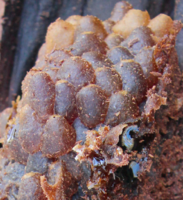
Bees are winged insects closely related to wasps and ants, known for their roles in pollination and, in the case of the best-known bee species, the western honey bee, for producing honey. Bees are a monophyletic lineage within the superfamily Apoidea. They are currently considered a clade, called Anthophila. There are over 20,000 known species of bees in seven recognized biological families. Some species – including honey bees, bumblebees, and stingless bees – live socially in colonies while most species (>90%) – including mason bees, carpenter bees, leafcutter bees, and sweat bees – are solitary.

A honey bee is a eusocial flying insect within the genus Apis of the bee clade, all native to mainland Afro-Eurasia. After bees spread naturally throughout Africa and Eurasia, humans became responsible for the current cosmopolitan distribution of honey bees, introducing multiple subspecies into South America, North America, and Australia.
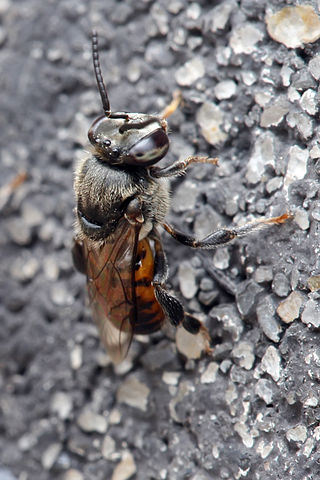
Stingless bees (SB), sometimes called stingless honey bees or simply meliponines, are a large group of bees (from about 462 to 552 described species), comprising the tribe Meliponini (or subtribe Meliponina according to other authors). They belong in the family Apidae (subfamily Apinae), and are closely related to common honey bees (HB, tribe Apini), orchid bees (tribe Euglossini), and bumblebees (tribe Bombini). These four bee tribes belong to the corbiculate bees monophyletic group. Meliponines have stingers, but they are highly reduced and cannot be used for defense, though these bees exhibit other defensive behaviors and mechanisms. Meliponines are not the only type of bee incapable of stinging: all male bees and many female bees of several other families, such as Andrenidae and Megachilidae (tribe Dioxyini), also cannot sting.

Australian native bees are a group of bees that play a crucial role in the pollination of native plants. There are over 1,700 species of native bees in Australia, ranging from small solitary bees to the social stingless bees. Native bees are important for native ecosystems, providing pollination services to native plants, and hold value for Australian agriculture.

Tetragonula carbonaria is a stingless bee, endemic to the north-east coast of Australia. Its common name is sugarbag bee. They are also occasionally referred to as bush bees. The bee is known to pollinate orchid species, such as Dendrobium lichenastrum, D. toressae, and D. speciosum. It has been identified as an insect that collects pollen from the cycad Cycas media. They are also known for their small body size, reduced wing venation, and highly developed social structure comparable to honey bees.

Bombus vosnesenskii, the yellow-faced bumblebee, is a species of bumblebee native to the west coast of North America, where it is distributed from British Columbia to Baja California. It is the most abundant species of bee in this range, and can be found in both urban and agricultural areas. Additionally, B. vosnesenskii is utilized as an important pollinator in commercial agriculture, especially for greenhouse tomatoes. Though the species is not currently experiencing population decline, urbanization has affected its nesting densities, and early emergence of the B. vosnesenskii has been implicated in the increasing lack of bee diversity on the West coast.

Bombus fervidus, the golden northern bumble bee or yellow bumblebee, is a species of bumblebee native to North America. It has a yellow-colored abdomen and thorax. Its range includes the North American continent, excluding much of the southern United States, Alaska, and the northern parts of Canada. It is common in cities and farmland, with populations concentrated in the Northeastern part of the United States. It is similar in color and range to its sibling species, Bombus californicus, though sometimes also confused with the American bumblebee or black and gold bumblebee. It has complex behavioral traits, which includes a coordinated nest defense to ward off predators. B. fervidus is an important pollinator, so recent population decline is a particular concern.

Tetragonisca angustula is a small eusocial stingless bee found in México, Central and South America. It is known by a variety of names in different regions. A subspecies, Tetragonisca angustula fiebrigi, occupies different areas in South America and has a slightly different coloration.

The Indian stingless bee or dammar bee, Tetragonula iridipennis, is a species of bee belonging to the family Apidae, subfamily Apinae. It was first described by Frederick Smith in 1854 who found the species in what is now the island of Sri Lanka. Many older references erroneously placed this species in Melipona, an unrelated genus from the New World, and until recently it was placed in Trigona, therefore still often mistakenly referred to as Trigona iridipennis. For centuries, colonies of T. iridipennis have been kept in objects such as clay pots so that their highly prized medicinal honey can be utilized.

Melipona bicolorLepeletier, 1836, commonly known as Guaraipo or Guarupu, is a eusocial bee found primarily in South America. It is an inhabitant of the Araucaria Forest and the Atlantic Rainforest, and is most commonly found from South to East Brazil, Bolivia, Argentina, and Paraguay. It prefers to nest close to the soil, in hollowed trunks or roots of trees. M. bicolor is a member of the tribe Meliponini, and is therefore a stingless bee. This species is unique among the stingless bees species because it is polygynous, which is rare for eusocial bees.

Trigona corvina is a species of stingless bee that lives primarily in Central and South America. In Panama, they are sometimes known as zagañas. They live in protective nests high in the trees, but they can be extremely aggressive and territorial over their resources. They use their pheromones to protect their food sources and to signal their location to nest mates. This black stingless bees of the tribe Meliponini can be parasitic toward citrus trees but also helpful for crop pollination.

Tetragonula hockingsi is a small stingless bee native to Australia. It is found primarily in Queensland. The colonies can get quite large, with up to 10,000 workers and a single queen. Workers of Tetragonula hockingsi have been observed in fatal fights with other Tetragonula species, where the worker bees risk their lives for the potential benefit of scarce resources.
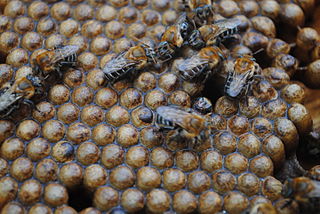
Melipona scutellaris is a eusocial stingless bee species of the order Hymenoptera and the genus Melipona. It is considered to be the reared Melipona species with the largest distribution in the North and Northeast regions of Brazil, with records from Rio Grande do Norte down to Bahia. Its common name, Uruçu, comes from the Tupi "eiru su", which in this indigenous language means "big bee". Their honey is highly desirable and the materials they create for nests have been proven to be a promising source of antibiofilm agents and to present selectivity against human cancer cell lines at low concentrations compared to normal cells.

Trigona fulviventris, known by the common names culo-de-vaca, culo-de-señora, mu'ul-kab, culo-de-buey, and culo-de-vieja, is a species of stingless bee found in Mexico and neotropical regions of Central and South America. It is one of the largest and most widespread bees of its genus. They exhibit complex foraging behaviors by integrating spatio-temporal learning and flower scents. T. fulviventris has traditionally been observed to abstain from aggressive behavior with other species; however, more recent analyses have shown that T. fulviventris emit pheromones that act as attack signals particularly when related individuals are captured by predators.
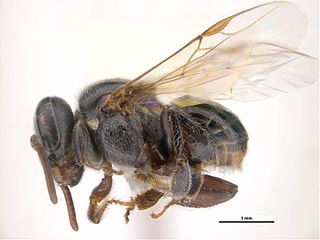
Austroplebeia is a stingless bee (Meliponini) genus in the family Apidae. The genus was erected by Jesus Santiago Moure in 1961. The genus comprises five described species endemic to Australia and New Guinea.Austroplebeia are more closely related to the African stingless bees than rest of the species found in Asia and Australia.

Austroplebeia australis is a stingless bee species in the tribe Meliponini first validly described by Heinrich Friese in 1898. Within Australia, they are occasionally referred to as bush bees.
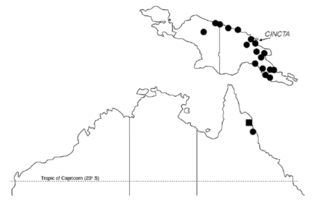
Austroplebeia cincta is a small eusocial stingless bee first described by Mocsáry in 1898 and it is found across Australia, West Papua, and Papua New Guinea.

Austroplebeia cassiae is a small eusocial stingless bee first described by Cockerell in 1910 and it is found in Australia.
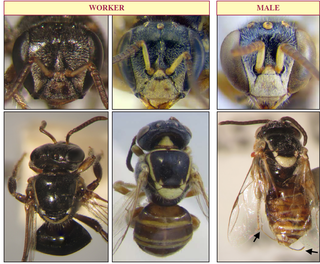
Austroplebeia essingtoni is a small eusocial stingless bee first described by Cockerell in 1905 and it is found in Australia. They are one of the smallest stingless bees in Australia and can survive in very arid areas with annual rainfalls down to 300 mm.

Tetragonula mellipes is a small eusocial stingless bee first described by Friese in 1898 and it is found in Northern Australia.




